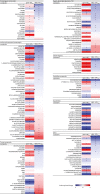Experimental evolution of metabolism under nutrient restriction: enhanced amino acid catabolism and a key role of branched-chain amino acids
- PMID: 37475747
- PMCID: PMC10355184
- DOI: 10.1093/evlett/qrad018
Experimental evolution of metabolism under nutrient restriction: enhanced amino acid catabolism and a key role of branched-chain amino acids
Abstract
Periodic food shortage is a common ecological stressor for animals, likely to drive physiological and metabolic adaptations to alleviate its consequences, particularly for juveniles that have no option but to continue to grow and develop despite undernutrition. Here we study changes in metabolism associated with adaptation to nutrient shortage, evolved by replicate Drosophila melanogaster populations maintained on a nutrient-poor larval diet for over 240 generations. In a factorial metabolomics experiment we showed that both phenotypic plasticity and genetically-based adaptation to the poor diet involved wide-ranging changes in metabolite abundance; however, the plastic response did not predict the evolutionary change. Compared to nonadapted larvae exposed to the poor diet for the first time, the adapted larvae showed lower levels of multiple free amino acids in their tissues-and yet they grew faster. By quantifying accumulation of the nitrogen stable isotope 15N we show that adaptation to the poor diet led to an increased use of amino acids for energy generation. This apparent "waste" of scarce amino acids likely results from the trade-off between acquisition of dietary amino acids and carbohydrates observed in these populations. The three branched-chain amino acids (leucine, isoleucine, and valine) showed a unique pattern of depletion in adapted larvae raised on the poor diet. A diet supplementation experiment demonstrated that these amino acids are limiting for growth on the poor diet, suggesting that their low levels resulted from their expeditious use for protein synthesis. These results demonstrate that selection driven by nutrient shortage not only promotes improved acquisition of limiting nutrients, but also has wide-ranging effects on how the nutrients are used. They also show that the abundance of free amino acids in the tissues does not, in general, reflect the nutritional condition and growth potential of an animal.
Keywords: Drosophila melanogaster; deamination; dietary restriction; experimental evolution; malnutrition; metabolomics.
© The Author(s) 2023. Published by Oxford University Press on behalf of The Society for the Study of Evolution (SSE) and European Society for Evolutionary Biology (ESEN).
Conflict of interest statement
The authors declare no conflict of interest.
Figures





Similar articles
-
Evolutionary adaptation to juvenile malnutrition impacts adult metabolism and impairs adult fitness in Drosophila.Elife. 2023 Oct 17;12:e92465. doi: 10.7554/eLife.92465. Elife. 2023. PMID: 37847744 Free PMC article.
-
Experimental evolution of post-ingestive nutritional compensation in response to a nutrient-poor diet.Proc Biol Sci. 2020 Dec 9;287(1940):20202684. doi: 10.1098/rspb.2020.2684. Epub 2020 Dec 2. Proc Biol Sci. 2020. PMID: 33259760 Free PMC article.
-
Effects on nitrogen balance and metabolism of branched-chain amino acids by growing pigs of supplementing isoleucine and valine to diets with adequate or excess concentrations of dietary leucine.J Anim Sci. 2020 Nov 1;98(11):skaa346. doi: 10.1093/jas/skaa346. J Anim Sci. 2020. PMID: 33095867 Free PMC article.
-
Protein restriction and branched-chain amino acid restriction promote geroprotective shifts in metabolism.Aging Cell. 2022 Jun;21(6):e13626. doi: 10.1111/acel.13626. Epub 2022 May 8. Aging Cell. 2022. PMID: 35526271 Free PMC article. Review.
-
Metabolism of branched-chain amino acids in altered nutrition.Metabolism. 1976 Nov;25(11):1287-302. doi: 10.1016/s0026-0495(76)80012-1. Metabolism. 1976. PMID: 790082 Review.
Cited by
-
Cis-regulatory polymorphism at fiz ecdysone oxidase contributes to polygenic evolutionary response to malnutrition in Drosophila.PLoS Genet. 2024 Mar 7;20(3):e1011204. doi: 10.1371/journal.pgen.1011204. eCollection 2024 Mar. PLoS Genet. 2024. PMID: 38452112 Free PMC article.
-
Selection for early reproduction leads to accelerated aging and extensive metabolic remodeling in Drosophila melanogaster.bioRxiv [Preprint]. 2025 Mar 9:2024.06.28.601037. doi: 10.1101/2024.06.28.601037. bioRxiv. 2025. Update in: Genome Biol Evol. 2025 Apr 30;17(5):evaf082. doi: 10.1093/gbe/evaf082. PMID: 39005259 Free PMC article. Updated. Preprint.
-
Shared genetic architecture links energy metabolism, behavior and starvation resistance along a power-endurance axis.Evol Lett. 2024 Nov 11;9(1):150-162. doi: 10.1093/evlett/qrae062. eCollection 2025 Feb. Evol Lett. 2024. PMID: 39906580 Free PMC article.
-
Evolutionary adaptation to juvenile malnutrition impacts adult metabolism and impairs adult fitness in Drosophila.Elife. 2023 Oct 17;12:e92465. doi: 10.7554/eLife.92465. Elife. 2023. PMID: 37847744 Free PMC article.
-
Selection for Early Reproduction Leads to Accelerated Aging and Extensive Metabolic Remodeling in Drosophila melanogaster.Genome Biol Evol. 2025 Apr 30;17(5):evaf082. doi: 10.1093/gbe/evaf082. Genome Biol Evol. 2025. PMID: 40326415 Free PMC article.
References
-
- Blumrich, A., Vogler, G., Dresen, S., Diop, S. B., Jaeger, C., Leberer, S., Grune, J., Wirth, E. K., Hoeft, B., Renko, K., Foryst-Ludwig, A., Spranger, J., Sigrist, S., Bodmer, R., & Kintscher, U. (2021). Fat-body brummer lipase determines survival and cardiac function during starvation in Drosophila melanogaster. iScience, 24(4), 102288. 10.1016/j.isci.2021.102288 - DOI - PMC - PubMed
-
- Boggs, C. L. (2009). Understanding insect life histories and senescence through a resource allocation lens. Functional Ecology, 23(1), 27–37. 10.1111/j.1365-2435.2009.01527.x - DOI
LinkOut - more resources
Full Text Sources
Molecular Biology Databases

